Fond de Volaille

Shall we talk about stock? I know that sometimes fresh homemade stock can be the make or break factor in a decision to cook a certain dish. Have you ever discarded the idea of a recipe because it called for homemade stock (and referred you to yet another page number)? Now is the time to consider that with a very small weekly expense and effort, you can always have that stock on hand. The more you use it, the more you’ll see the difference it makes in your cooking.
Having stock of various concentrations on hand is not a luxury. It is a necessity for anyone who takes cooking seriously and wants to make the difference between just dabbling from time to time and being a good cook. It takes no special skill or innovation, in fact it is one of the easiest ways you can appreciably improve your cooking.
Some cooks recommend using high end poultry cuts or whole birds in stock making, but I have found through experience that I get a more flavorful stock with a better viscosity by using only wings and necks, which are also cheaper. Due to the high level of cartilage in these parts, they give a more gelatinous, rich, and flavorful stock. That is good news, isn’t it?

In French, the word for stock is fond, alluding to its role as a foundation upon which good cooking will take form. The primary goal of stock is of course to provide a backdrop to a soup or a sauce, like priming a canvas for painting. Another important use for reduced stock which is sometimes called glaze or glace in French, is to provide a certain finish - like a painter uses the glaze technique to allow a painting’s many applied layers to catch the light. If you have ever been mesmerized by the depth and purity of color in a Rothko color field or even felt inspired by the luminescence radiating in the shadows of a Rembrandt, you have appreciated the use of the glaze technique in painting. If you have ever finished a sauce with veal or poultry demi-glace or glace, you can understand that it takes the quality and richness of your sauce to a higher plane of expression.
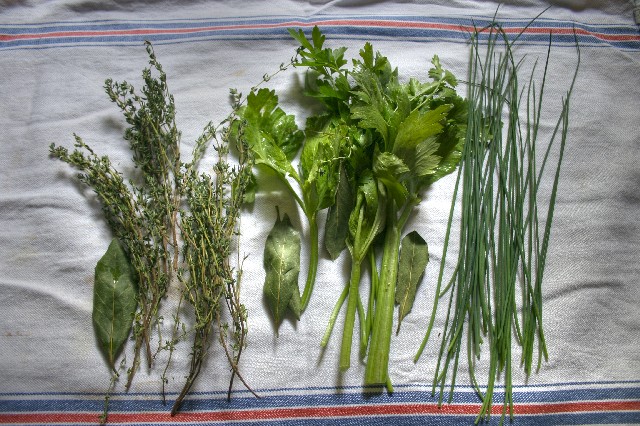
I choose my ingredients for stock with the idea of keeping the flavor balanced. It is the secret to good cooking. A poultry stock should not have a strong flavor of any one particular ingredient other than that of poultry. I don’t hesitate to add carrots, and onions and the occasional pink shallot to my stock because they are great team players that enrich the flavor in general. I also believe that a judiciously assembled herb bouquet also has a place in a mixed poultry stock.

Certain flavorful aromatics, tubers and vegetables in the onion family with strong personalities like tarragon, turnips, parsnips, grey shallots, garlic and leeks do not have a place in my basic stock. If I want to add the flavors of these vegetables to a soup or make a dish that puts them in the leading role, they are certainly welcome in my kitchen, just not in my basic weekly stock.
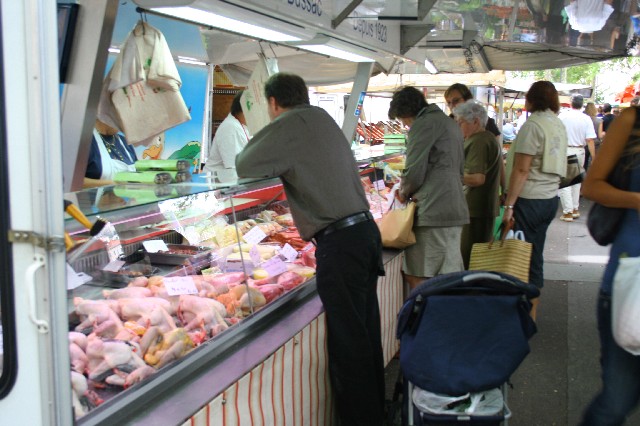
Every week I head down to my volailler on the riverside and pick up the poultry. These days I use chicken wings, duck wings, and guinea hen (pintade) necks, which are her cheap cuts. I rarely spend more than €5 on my mixed poultry stock. For example today, 2 kilos of duck wings, a kilo of chicken wings, a duck neck and 2 pintade necks cost me about €4. I am going to make a batch of regular stock and a batch of demi-glace to use during the week, so I am doubling my normal batch of stock. Here is my recipe for one batch:
Fond de volaille & demi-glace (mixed poultry stock and glaze)
Yields 2 ½ to 3 liters of stock.
4 pounds or 2 kilos of chicken or mixed poultry parts: backs, wings, necks, and feet if available.
1 basic bouquet garni – celery, bay, thyme, parsley, using chives to tie.
2 carrots
1 onion
4 black peppercorns
cold tap water
- Rinse and clean the poultry parts, and place them in a large stock pot.
- Peel and chop the carrot and onion into chunks and place them into the pot with the chicken. Tie your bouquet garni. Add the peppercorns, and the bouquet garni, which you should tuck in between pieces of meat to keep it from floating to the top.
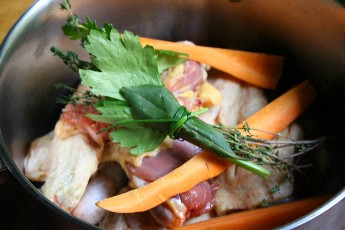 Remember to take that bouquet and tuck it under a piece of meat.
Remember to take that bouquet and tuck it under a piece of meat.- Add enough cold water to cover the meat by an inch or two (5cm) and bring to a boil over high heat.
- Let the soup boil at a rolling boil for 4 minutes, and use a wire skimmer to remove any foam and sediment that comes to the top during that time. During the initial boiling, the meat releases blood and marrow. It coagulates and floats to the top. It should be removed from the top to allow for a clear final stock. Once you reduce the heat, it will generally stop producing sediment.
- Reduce the heat to low. Partially cover the pot to leave an opening of about 2 inches to let steam to escape. Allow the soup to just barely simmer for 1.5 hours. Don’t let the soup boil on and on at a rolling boil, it will cloud and take on a livery taste. The top surface of the soup should slightly tremble. Don’t ever completely cover and seal a simmering stock. If you do let it simmer longer than usual, turn the heat way down. Don’t let it simmer much longer than 2 hours while it still contains the meat, since it will take on a bitter stale flavor from the bones if it cooks too long.
- Remove the long poached meat, bouquet, carrot, and onion from the stockpot, using a slotted spoon. Set the meat aside to cool. You will remove the good meat from the bones for use in other dishes.
 Think salads, pot pies, poultry and dumpling dishes, stuffed ravioli, rillettes, spreads, and more.
Think salads, pot pies, poultry and dumpling dishes, stuffed ravioli, rillettes, spreads, and more.- Strain the stock into a tempered glass jar (meaning that the jar can handle sudden heat), and leave it to cool down to room temperature. I find that 1.5 liter jelly jars do very well.

- Once the stock is cool enough, place the jars in the refrigerator, to chill until the fat on top has set. (I leave mine overnight). You can easily degrease (remove the fat from) the stock by scraping it off the surface when it is chilled. The poultry fat you remove from the chilled stock can be used in cooking.
- Add salt to the stock to taste once you are certain of its final use. Waiting to salt the stock avoids over-salting should a soup or sauce be reduced.
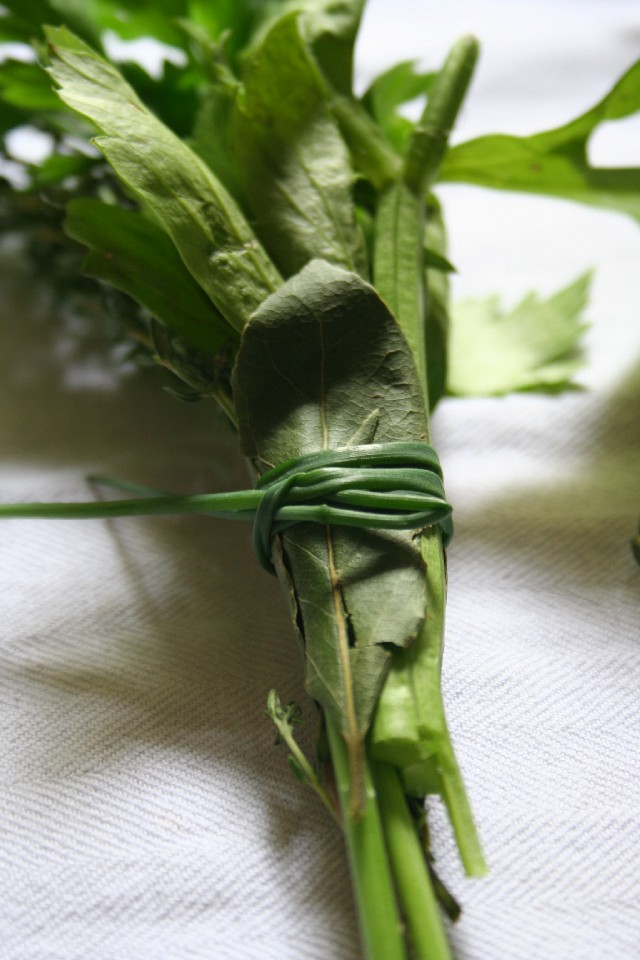
To make demi-glace or glace de volaille: Place one quart of carefully degreased stock into a saucepan, and bring to a boil. Boil to evaporate it down to 1 cup. Salt to taste, if desired. Strain it into a jar to keep in the refrigerator for use. It will form a hard jelly that can be spooned out and used as needed in enriching the taste of savory tarte and tourte fillings, in sauces, egg dishes such as soufflés and omlettes, and as a flavor booster in any savory dish.
To make clear consommé: Blend one 3 oz. Or 100 grams raw skinless chicken breast with fat and sinews removed, one egg white, and 1 quart completely degreased cold stock together in the food processor or blender until smooth and homogenous. Pour mixture into a saucepan and bring to a simmer but not to a boil. Move the pan so that the fire is heating up one side of the pan, and let it simmer that way, the stock circulating slowly up and through the crust that forms from the egg white & chicken mixture. It is a complex filtering system that will completely remove the impurities and sediment from the stock. Simmer for 15 minutes, rotating the pan periodically to ensure that all of the liquid filters, but do not touch or stir the egg white and chicken filter. Before serving, line a chinois or colander with a clean linen which has been rinsed with water to ensure that absolutely no trace of perfume from detergent remains in the fabric. Strain the soup through the lined chinois for the ultimate clear sparkling broth. You may enrich this with a few spoonfuls of cognac before salting to taste, and serving. This consommé is ideal for aspics.
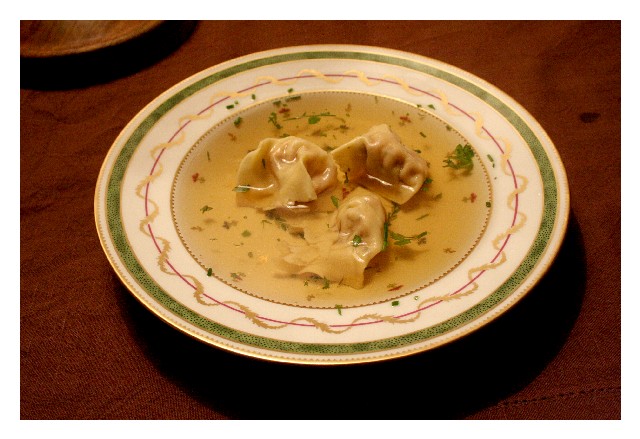
This is a Consommé de poule de Bresse with home made foie gras ravioli. I like to start the meal at Thanksgiving with this soup.
Labels: Autumn, Classic French Cooking, Fall 06, soups



























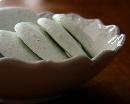








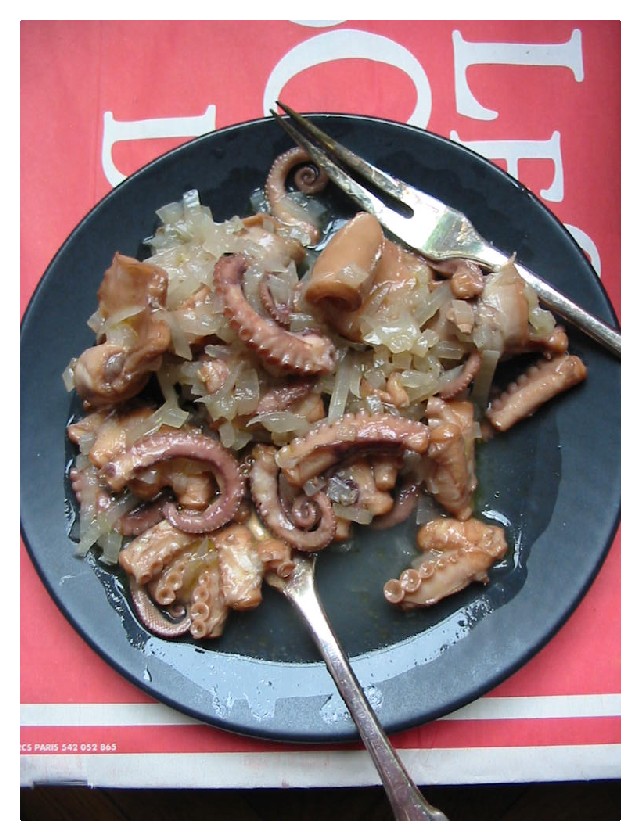


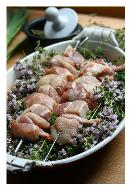












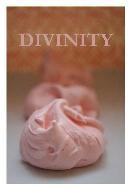
8 Comments:
Wonderful demo, Lucy! What do you think of Patricia Wells' suggestion to blanch the chicken/poultry before starting the stock? I tried this last week and it certainly seemed to cut down on the final amount of fat to scrape off. Also, do you ever make veal stock?
P.S. I've been enjoying your blog since January--it's one of my favorites!
When I moved to France, I was miffed I couldn't get canned chicken stock, so I started making my own again. What a difference! Everything I made tasted so much better!
In Paris, you need to order chicken bones in advance, which is a drag because you need to think ahead.
Although come to think of it, I did have a chicken carcass around here,somewhere...if I could only find it...
Reading this entry was just like watching my nonna making stock. The only difference is that she'd reduce the heat to simmer immediately after it came to a rolling boil.
Many, many thanks for the lovely photos and detailed explanations.
MS
You are correct in mentioning how the taste differs in homemade stock...there is no comparison! Great post today1 Thanks so much!
Thanks for your kind comments, everyone!
Dear Sarah, I think that blanching and then changing the water is most likely to remove any surface impurities from the chicken that it may have picked up in packing, etc. Poultry fat is generally rendered throughout the slow cooking process and not in the first few minutes of cooking. However If Patricia Wells does it and the method suits you, you should go ahead and keep it up!
David, I do hope you manage to find that carcass.
Francini, I will illustrate the use of demi-glace in savory tourtes for you in the coming weeks. Thank you for your good questions.
MS and Jann, Thanks for your kind comments. I am so glad that you appreciated the post.
Hi Lucy,
I've been to the market today and got a pile of organic chicken carcasses because I'd love to try out your mixed poultry stock recipe. I've bought goose necks and wings, too. But, um, now I've found out, you'd taken duck pieces. And I'm hesitating. Can they go into the stock or should I better do anything else with them?
Go ahead and use the goose! If the skin has an extra fatty layer, you might peel the skin off. The other day, I even threw in a couple of rabbit backs!
Lucy, thank you very much, and especially for your fast reply, they're all in the slowly bubbling pot now and the whole house smells wonderful :-)
Post a Comment
<< Home